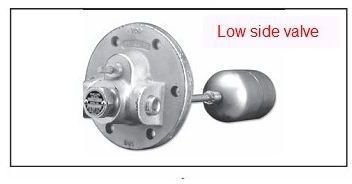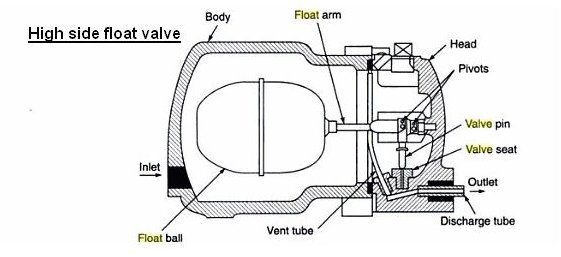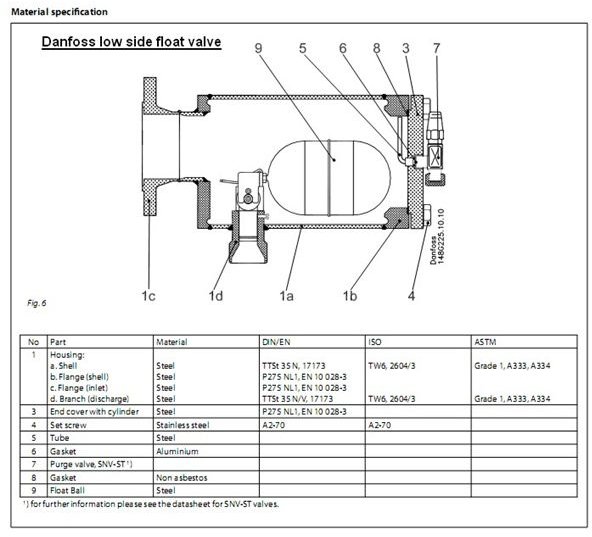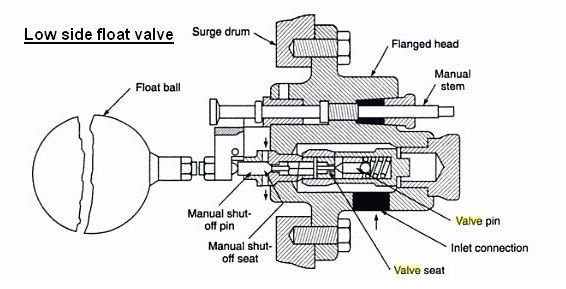Float Valve used as Throttling Device in Refrigerator Systems
Float valve is used as the throttling device in the large industrial refrigeration plants that fulfill the cooling requirements of the entire process. There are two types of float valves as discussed below:
Low Side Float Valves
The low side float type of the throttling valve is usually used in the flooded type of the refrigeration plants. In industrial refrigeration plants the evaporators are of shell and tube type. In the plants with medium capacity the refrigerant is filled in the tube side and the substance to be chilled is filled in shell side such as in the water chilling plants. But when very low temperature is required for large quantity of the substance the refrigerant is filled in the shell side and the substance to be chilled is on tube side. Such types of evaporators are called as the flooded evaporators.
The float valve maintains the constant level of the liquid in the flooded evaporator irrespective of the pressure and the temperature inside it. The float of the low side float valve is placed in the evaporator, which is at low pressure. The construction and the working of the low side refrigeration float valve are similar to the float valve used in the water tank used for maintaining the level of the liquid.
In the water tank the float keeps floating inside on the water and its arm is connected to the water connection. When the level of the water drops down the arm of the float valve moves to open the water connection and allows the flow of the water to the tank. When the tank gets filled the float rises up and the arm closes the water connection. The float valve in the refrigeration plant also works in a similar manner.
The valve assembly of the low side float valve comprises of the hollow ball, a float arm, needle valve and the seat (refer the images below). The valve seat and the needle forms the orifice opening of the valve that provides the throttling effect to the refrigerant passing through it and through which the regulated amount of the refrigerant can pass. The valve seat and the needle are located inside the chamber of the float valve which is connected to the evaporator.
The hollow ball or float floats on the refrigerant inside the evaporator and moves up and down as per the level of the liquid. The hollow ball is connected to the needle and valve seat via the float arm. Thus as the ball moves up and down the float arm also moves that allows for the opening or the closing of the orifice.
When the level of the refrigerant drops inside the evaporator due to high refrigeration load the float moves down, this allows for the opening of the orifice of the valve increasing the flow of the refrigerant. When the sufficient amount of refrigerant enters the evaporator the level of the float rises due to which moves the float valve closes. The movement of the float and the opening of the float valve is in accordance to the refrigeration load on the evaporator.
Low Side Refrigeration Float Valve

High Side Float Valve
While in the low side float valve the float chamber is placed in the evaporator on low pressure side, in the high pressure side float valve and the float chamber is placed on the high pressure side between the condenser and the evaporator. In low side float valve the valve opens as the level of the refrigerant drops in the evaporator, but in high side float valve the valve opens when the level of the refrigerant increases in the chamber.
The refrigerant condensed in the condenser moves to the chamber of the high pressure float valve. As the level of the refrigerant rises the float ball moves up and opens the float valve that allows for the passage of the refrigerant through needle valve. The level of the refrigerant would rise in float chamber when more refrigerant is coming from the condenser that means there is more load on the plant. Thus when there is higher load on the plant there is increase in the flow of the refrigerant through the float valve (refer the image below).
The level of the refrigerant coming from the condenser reduces when there is less load on the plant. When the level of the refrigerant drops down the orifice of the needle valve closes, thus reducing the flow of the refrigerant through it. The high side float valves are usually used with the centrifugal refrigeration plants.
High Side Float Valve for Refrigeration Plants



Reference
- Book: Basic Refrigeration and Air Conditioning by P. N. Ananthanarayanan, Second Edition, Tata Mc-Graw-Hill Publishing Company Limited
Images Courtesy
-
Book: Basic Refrigeration and Air Conditioning by P. N. Ananthanarayanan, Second Edition, Tata Mc-Graw-Hill Publishing Company Limited
-
Phillips low side float valve manual
-
Danfoss high pressure float valve manual.
This post is part of the series: Throttling Devices, Expansion Valves in Refrigeration & Air Conditioning Systems
This is the series of articles that describes what the throttling valves are for the refrigeration and air conditioning systems. It also describes the functions of the throttling valves and also its types like capillary tube, automatic expansion valve, thermostatic expansion valve etc.
- Throttling Devices or the Expansion Valves Used in the Refrigeration and Air Conditioning Systems
- Capillary Tube for Refrigeration and Air Conditioning Systems
- Constant Pressure Expansion Valve or Automatic Expansion Valve
- Thermostatic Expansion Valve or TEV
- Float Valve used as the Throttling Device in Refrigeration Systems
